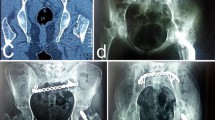Abstract
Purpose
The sacrum is a mechanical nucleus working as the base for the spinal column, as well as the keystone of the pelvic ring. Thus, injuries of the sacrum can lead to biomechanical instability and nerve conduction abnormality.
Methods
The common classification is the Denis classification, but these fractures are often part of a lesion of the posterior pelvic ring and therefore the Tile classification is very useful. The goals of operative intervention are to reduce fracture fragments, protect neurological structures, and provide adequate stability for early mobilization.
Results
The stabilization of these injuries can be difficult even in a patient with adequate bone stock and concomitant medical comorbidities. The posterior-ring tension-band metallic plate and sacroiliac joint screw are two commonly used methods for posterior internal fixation of the pelvis.
Conclusions
In this study, we evaluate the differences, in the treatment of sacral fractures, between the two techniques, revising the literature and our experience.




Similar content being viewed by others
References
Eastridge BJ, Starr A, Minei JP, O’Keefe GE, Scalea TM (2002) The importance of fracture pattern in guiding therapeutic decision-making in patients with hemorrhagic shock and pelvic ring disruptions. J Trauma 53(3):446–50-1
Poole GV, Ward EF (1994) Causes of mortality in patients with pelvic fractures. Orthopedics 17(8):691–696
Pohlemann T, Bosch U, Gänsslen A, Tscherne H (1994) The Hannover experience in management of pelvic fractures. ClinOrthopRelat Res 305:69–80
Schütz M, Stöckle U, Hoffmann R, Südkamp N, Haas N (1996) Clinical experience with two types of pelvic C-clamps for unstable pelvic ring injuries. Injury 27:p:46–50
Mohamad Bydon, Vance Fredrickson, R de la Garza-Ramos, Yiping L, RA Lehman Jr, GR Trost, ZL Gokaslan, (2014) Sacral fractures. AANS;37 (1)
Miller AN, Chip Routt ML Jr (2012) Variations in sacral morphology and implications for iliosacral screw fixation. J Am Acad Orthop Surg 20(1):8–16
Conflitti JM, Graves ML, Chip Routt ML Jr (2010) Radiographic quantification and analysis of dysmorphic upper sacral osseous anatomy and associated iliosacral screw insertions. J Orthop Trauma 24:630–636
Futamura K, Baba T, Mogami A, Morohashi I, Obayashi O, Iwase H, Kaneko K (2018) A biomechanical study of sacroiliac rod fixation for unstable pelvic ring injuries: verification of the “within ring” concept. Int Orthop 42(4):909–914. https://doi.org/10.1007/s00264-017-3713-x
Dubory A, Bouloussa H, Riouallon G, Wolff S (2017) A computed tomographic anatomical study of the upper sacrum. Application for a user guide of pelvic fixation with ilioscral screws in adult spinal deformity. Int Orthop 41(12):2543–2553. https://doi.org/10.1007/s00264-017-3580-5
Pishnamaz M, Dienstknecht T, Hoppe B, Garving C, Lange H, Hildebrand F, Kobbe P, Pape HC (2016) Assessment of pelvic injuries treated with ilio-sacral screws: injury severity and accuracy of screw positioning. Int Orthop 40(7):1495–1501. https://doi.org/10.1007/s00264-015-2933-1
Routt MLC, Simonian PT, Mills WJ (1997) Iliosacral screw fixation: early complications of the percutaneous technique. J Orthop Trauma 11(8):584–589
Tile M (1996) Acute pelvic fractures: I. Causation and classification. J AmAcadOrthopSurg 4(3):143–151
Altman DT, Jones CB, Routt MLC (1999) Superior gluteal artery injury during iliosacral screw placement. J Orthop Trauma 13(3):220–222
Nork SE, Jones CB, Harding SP, Mirza SK, Routt MLC (2001) Percutaneous stabilization of U-shaped sacral fractures using iliosacral screws: technique and early results. J Orthop Trauma 15(4):238–246
Bi C, Wang Q, Nagelli C, Wu J, Wang Q, Wang J (2016) Treatment of unstable posterior pelvic ring fracture with pedicle screw-rod fixator versus locking compression plate: a comparative study. Med SciMonit 22:3764–3770
Elzohairy MM, Salama AM (2017) Open reduction internal fixation versus percutaneous iliosacral screw fixation for unstable posterior pelvic ring disruptions. OrthopTraumatolSurg Res 103(2):223–227
Chen HW, Liu GD, Fei J et al (2012) Treatment of unstable posterior pelvic ring fracture with percutaneous reconstruction plate and percutaneous sacroiliac screws: a comparative study. J Orthop Sci 17(5):580–587
Acklin Y, Marco G, Sommer G(2014) Double locking plate fixation of sacral fractures in unstable pelvic ring C-type injuries.;(11):p: 1–6. https://doi.org/10.1007/s00064-014-0307-2
Futamura K, Baba T, Mogami A, Kanda A, Obayashi O, Iwase H, Kaneko K (2018) “Within ring”-based sacroiliac rod fixation may overcome the weakness of spinopelvic fixation for unstable pelvic ring injuries: technical notes and clinical outcomes. Int Orthop 42(6):1405–1411. https://doi.org/10.1007/s00264-017-3712-y
Wang H, Fu YH, Ke C, Zhuang Y, Zhang K, Wei X, Li Z, Lei JL, Zhang BF, Liu P (2018) Minimally invasive stabilisation of posterior pelvic ring instabilities with pedicle screws connected to a transverse rod. Int Orthop 42(3):681–686. https://doi.org/10.1007/s00264-017-3714-9
Author information
Authors and Affiliations
Corresponding author
Ethics declarations
Institutional review board statement
The study was reviewed and approved by the internal ethics committee of orthopedics and traumatology department of Policlinico Gemelli Hospital.
Informed consent statement
All involved persons gave their verbal informed consent prior to being included in the analysis.
Conflict of interest
The authors declare that they have no conflict of interest.
Rights and permissions
About this article
Cite this article
Liuzza, F., Silluzio, N., Florio, M. et al. Comparison between posterior sacral plate stabilization versus minimally invasive transiliac-transsacral lag-screw fixation in fractures of sacrum: a single-centre experience. International Orthopaedics (SICOT) 43, 177–185 (2019). https://doi.org/10.1007/s00264-018-4144-z
Received:
Accepted:
Published:
Issue Date:
DOI: https://doi.org/10.1007/s00264-018-4144-z




